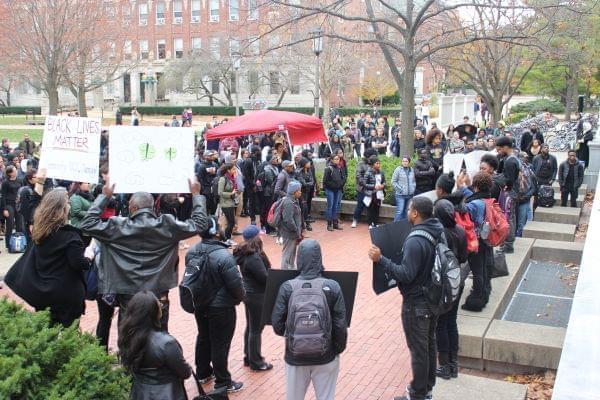Push Back Against Black Student Rally Calls Greater Attention To Racism On College Campuses

Several black student groups gather on the U of I quad in support of black students at the University of Missouri. Tiffany Jolley/Illinois Public Media
College campuses have played host in recent months to a series of protests against racism.
At the University of Missouri, two top administrators resigned earlier this month.
And last week on the University of Illinois’ Urbana campus, black students came together to show support for the students at Mizzou, and to share their own experiences with racism.
Hours later, a Facebook group appeared that denounced the protesters.
Questions have since come up about whether that Illini White Students Union page is legitimate.
But it represents the latest form of push back against a growing movement to call greater attention to racism on campuses.
Illinois Public Media’s Tiffany Jolley spoke with Hasan Kwame Jeffries, a history professor at Ohio State about what’s driving the protests and the pushback against them.
In this moment, where is this solidarity coming from?
“Well, that’s a good question. I think it is a question of solidarity. I think it’s more recognition of similar experiences and similar circumstances. I think it’s a solidarity that’s built on an understanding of a shared experience, and and this is where I think social media plays a big part, because it doesn’t necessarily build solidarity, but it draws attention to that shared circumstance and creates an avenue for people to reach out and connect.”
There’s a long history of student protest, but what is the significance of students being the ones to lead this movement?
“There is a long history of student activism, and this just isn’t a 1960s thing. Schools with predominately white campuses, schools like Illinois, Michigan, Ohio State, they’ve always had a small number of students of color and African-Americans, but you have a critical mass once you hit the mid-1960s and late 1960s. Once you have a handful of people saying, “Enough is enough, what can we do to make a difference?” Then I think you begin to move from moments to movements. It’s the cumulative effect of an atmosphere that just wears on you and wears on you, and then finally it really boils to a surface, and finally you get that release.”
When there is protest on behalf of minority rights, we often see push back against that movement. For example, here at the University of Illinois, students held a solidarity rally and later that day, a Facebook page for an ‘Illini White Students Union’ emerged. How does this compare to the push back from prior movements?
“It’s almost expected. I mean it falls right in line with what you can expect to happen once you have students of color and African-Americans operating inside a white society, in a predominately white culture, begin to organize. I think what you saw with that Facebook posting was that push back. So I think you’re always going to have push back, it’s just a question of where’s it going to come from and which side is the administration going to fall on?”
The University of Illinois, Missouri, Yale… for this generation of young black students, where do you see these movements heading?
“You know I think they will continue to build momentum, as students continue to reach out and connect with one another. If we see networks come out, and they’re starting to emerge, especially as an extension of the Black Lives Matter movement, then this moment will begin to look much more like a movement. What we’re seeing on this campus now, is an extension of what we saw on the streets, because these kids come from these communities. Now it’s a question of how are they going to connect with one another going forward, and be in conversation, because there is no fundamental difference from a black student at Illinois, to a black student at Ohio State, from a black student at Yale. It’s the same struggle of trying to find a space to fit in, and be a part of the university fully.”
Links
- Report Shows African Americans More Likely To Be Ticketed
- Champaign County NAACP Pres. Avery On Police & African American Relations
- What #BlackLivesMatter Means One Year Later
- U of I Report Details Episodes Of Racial Microaggressions
- Mixed Emotions Over Confederate Flag In Champaign
- SPLC Finds 21 Active Hate Groups In Illinois

